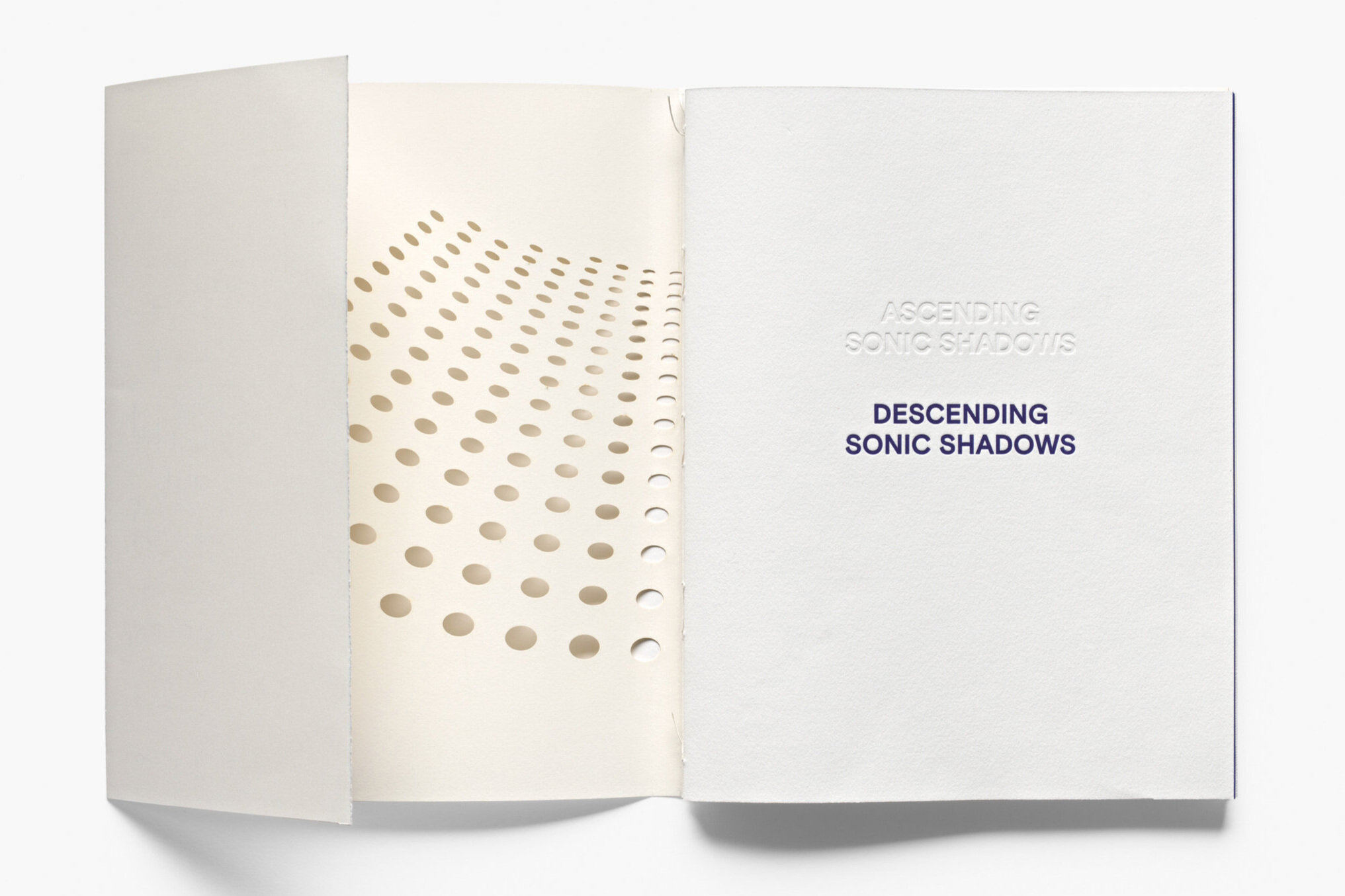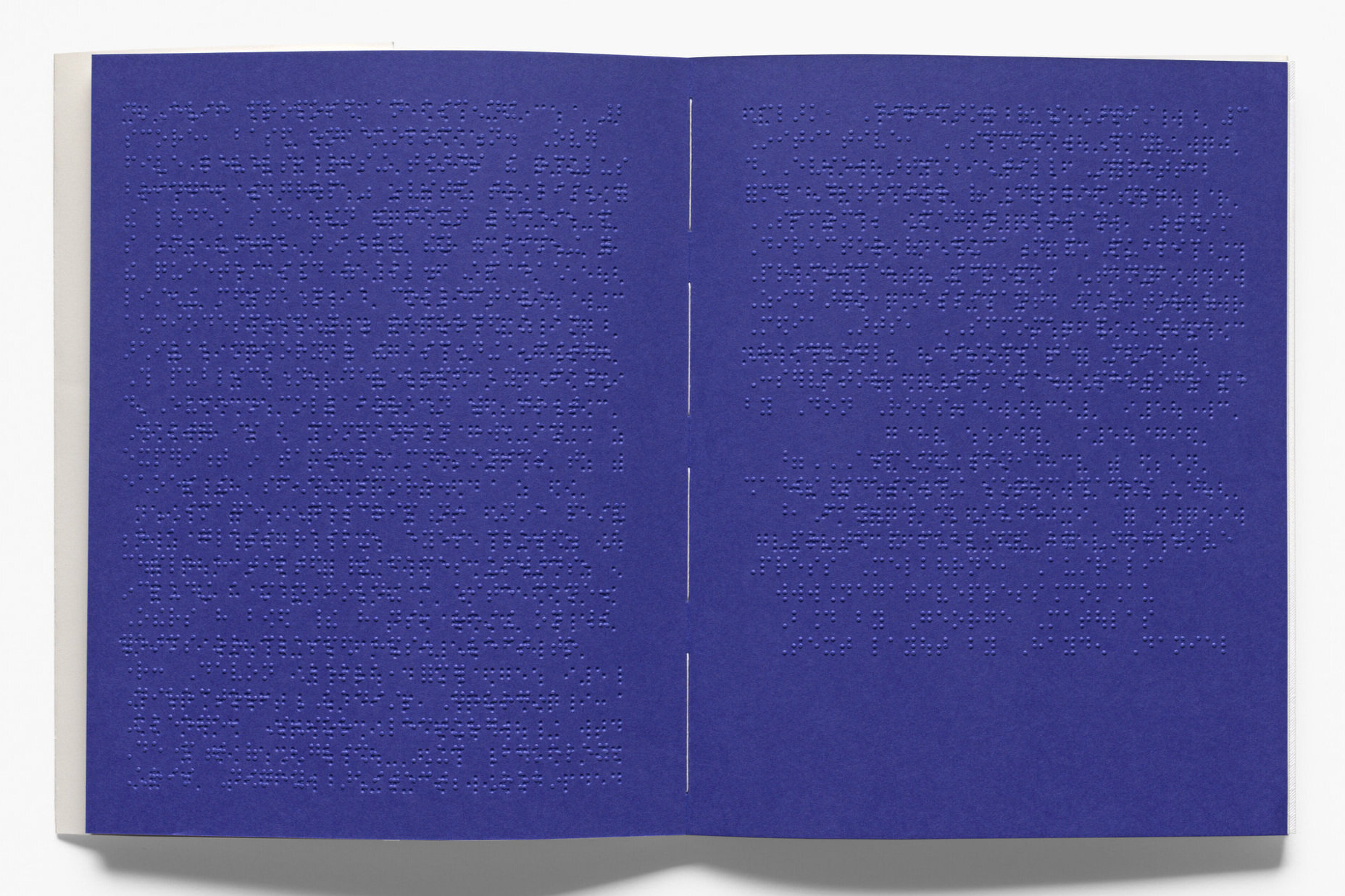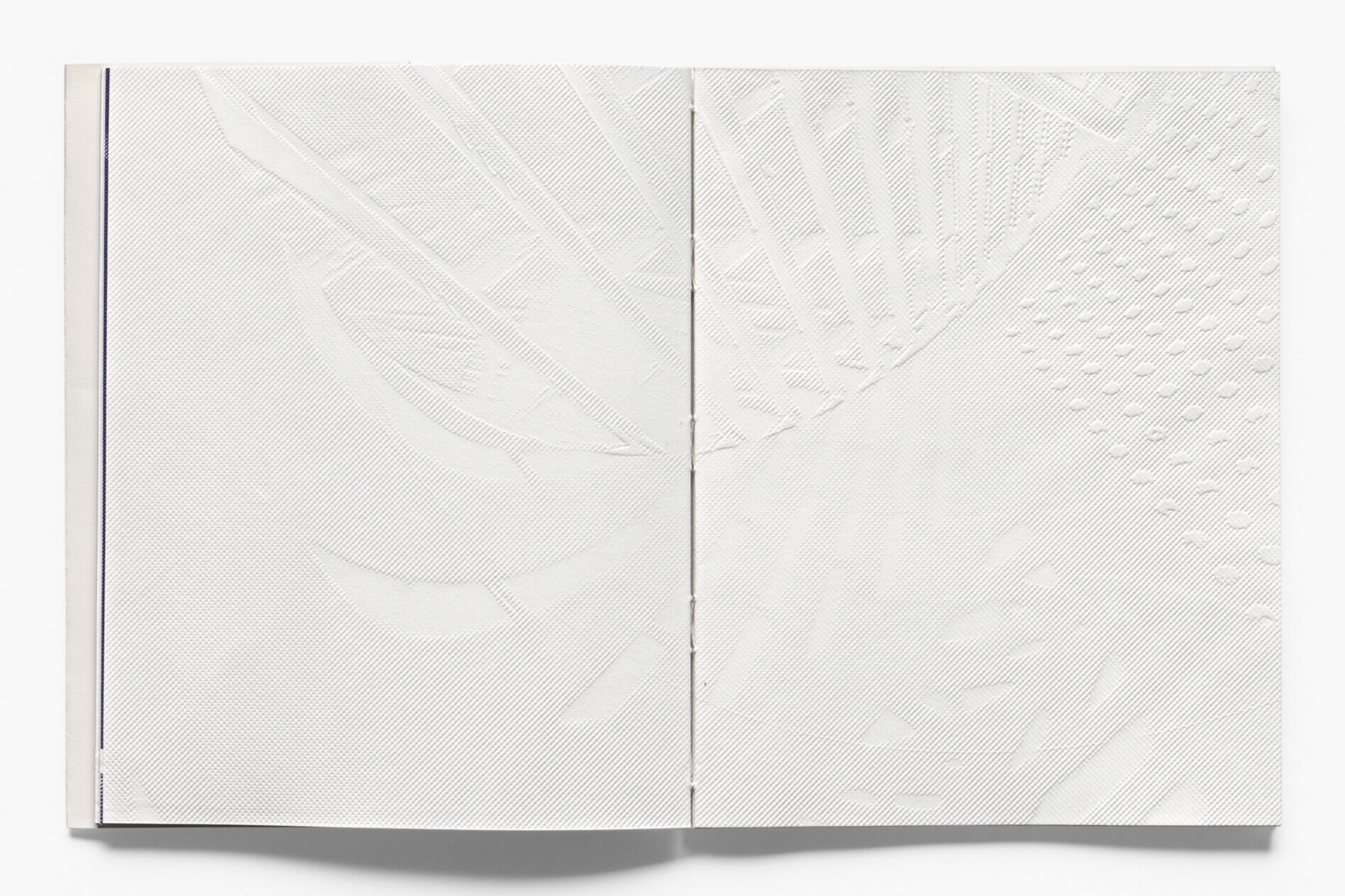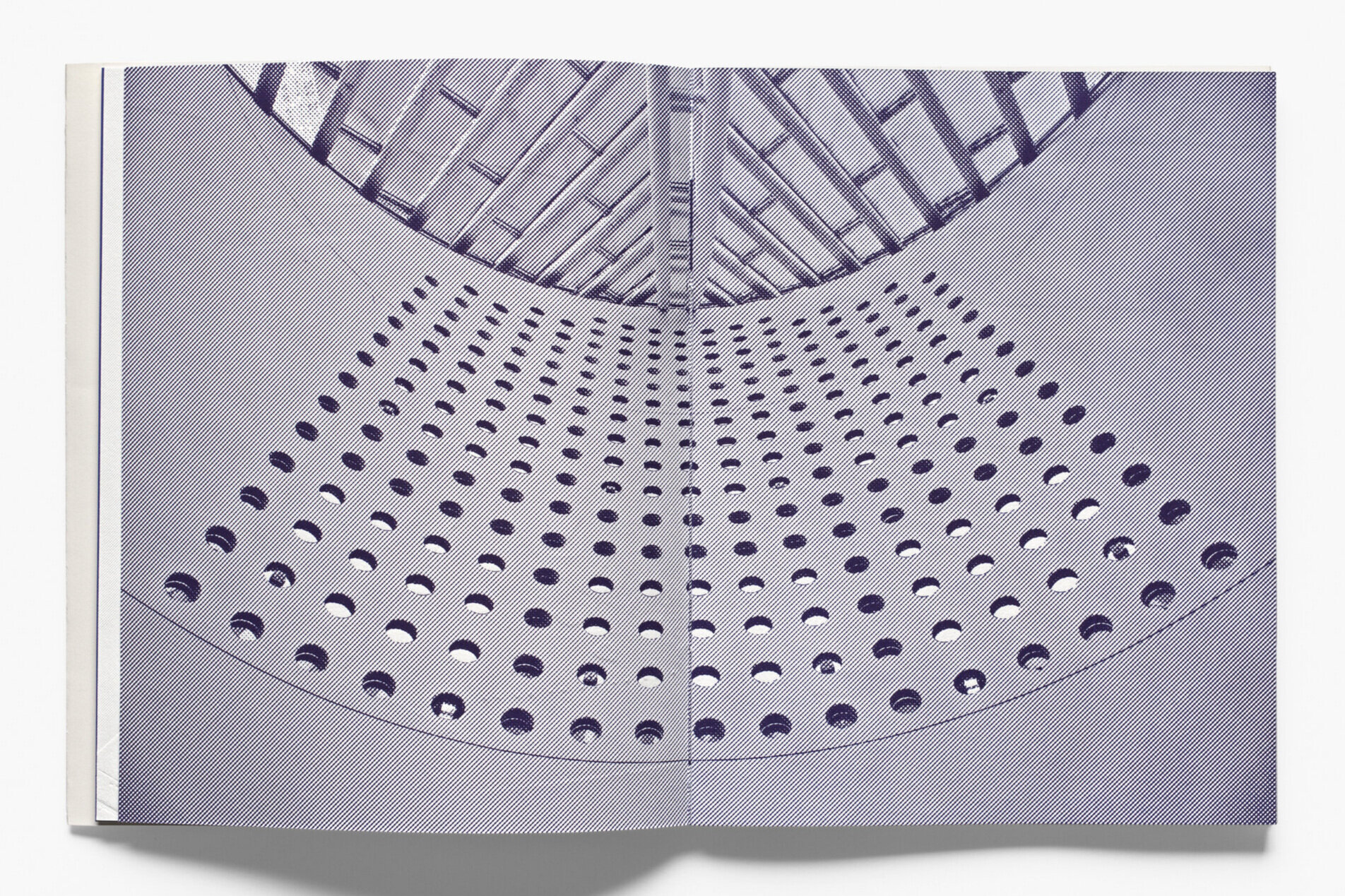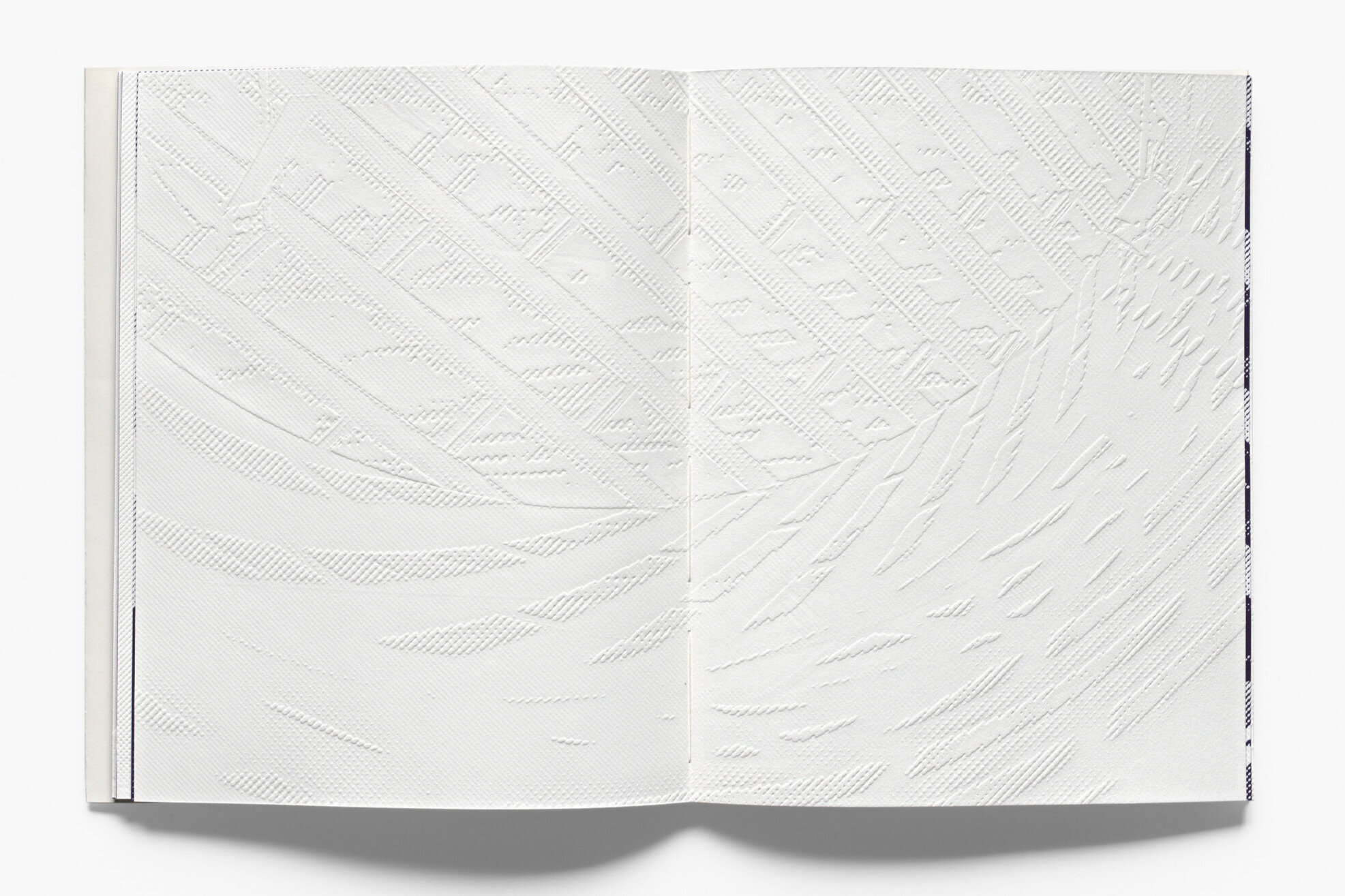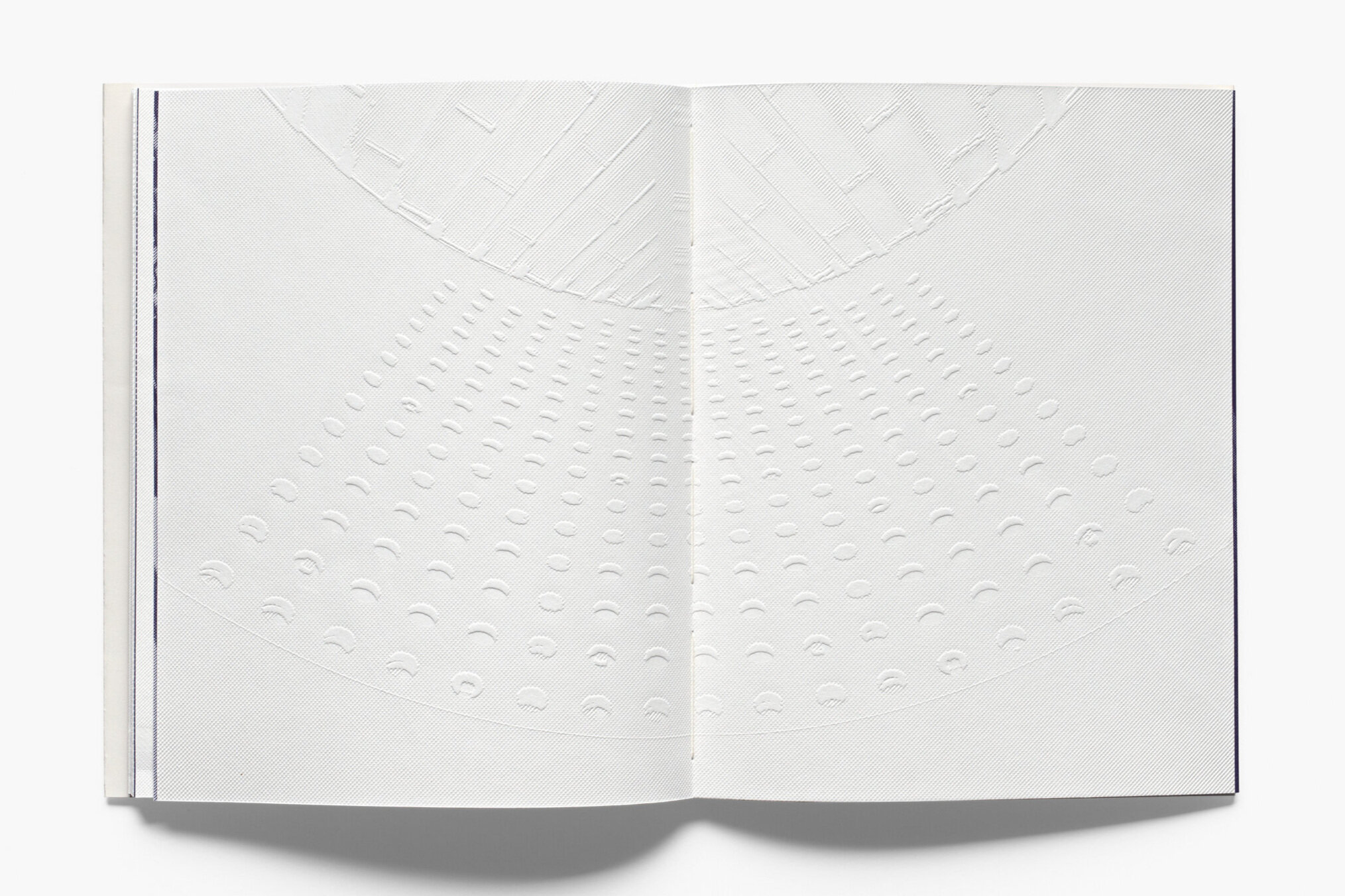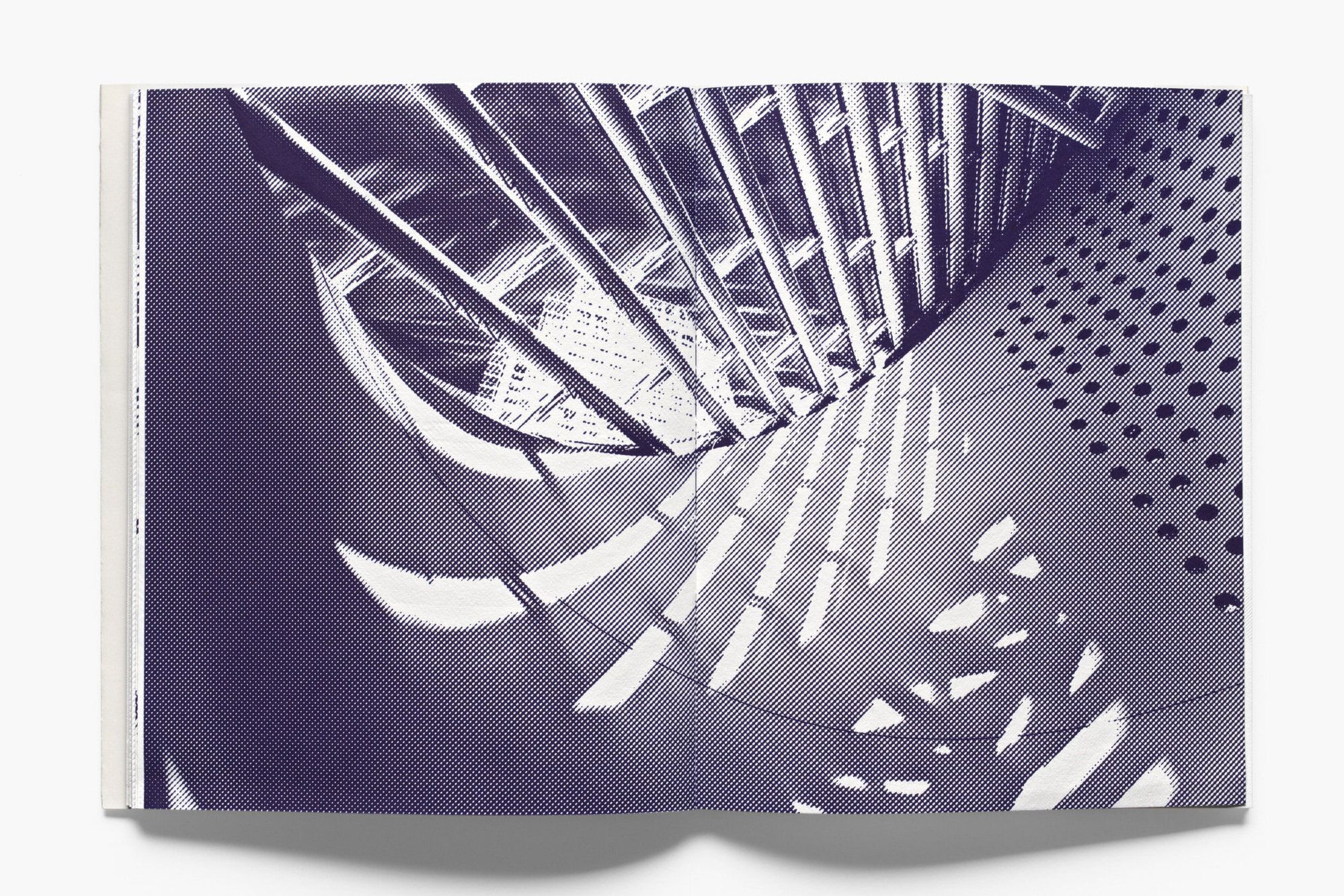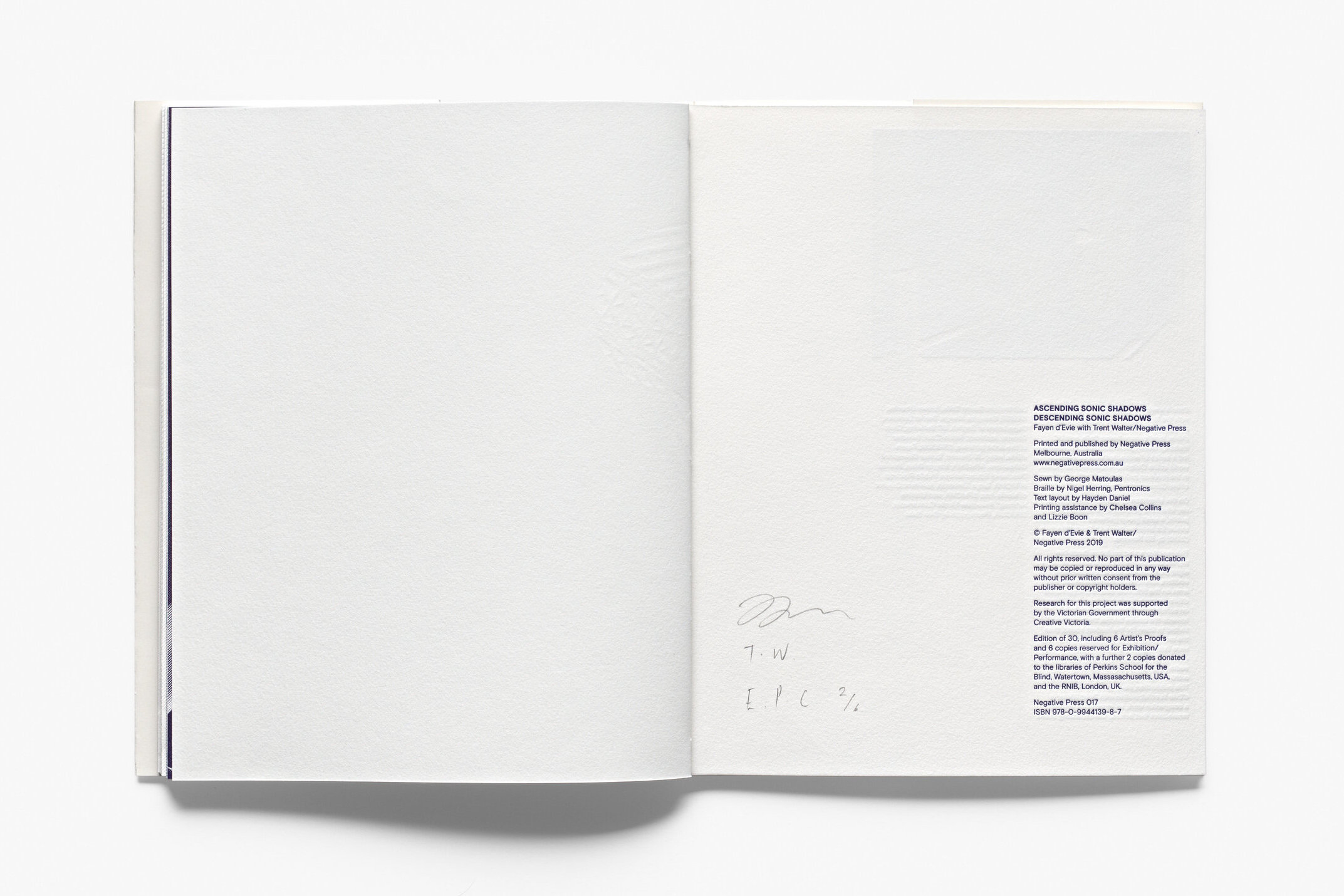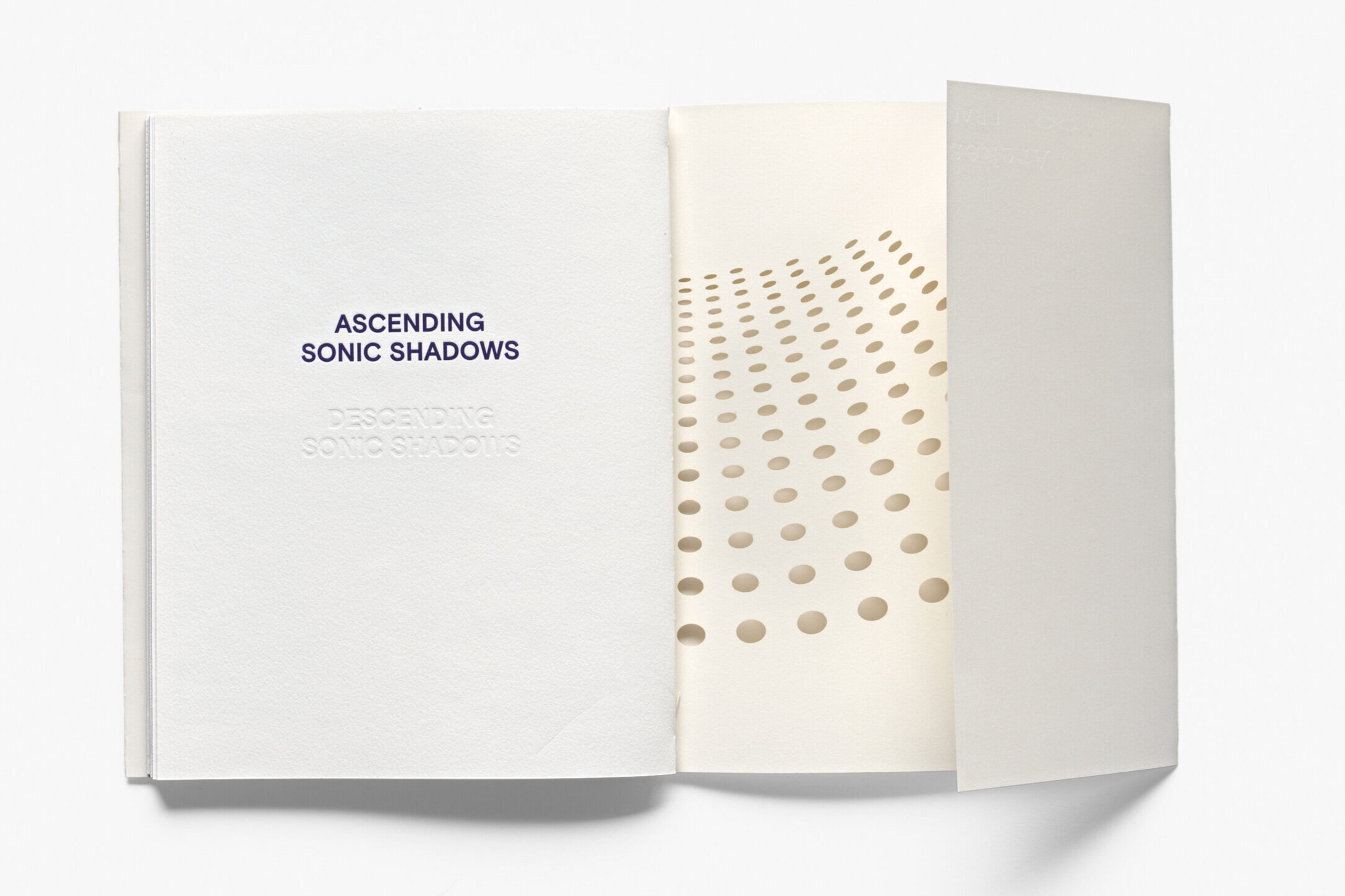Ascending Sonic Shadows
RE-CALLING an Encounter with
Sonic Shadows (2010) by Bill Fontana
at the San Francisco Museum of MODERN Art (SFMOMA)
on 19 July 2017
IMAGE DESCRIPTION: Nine people stand behind a glass railing, eyes closed. A couple have tilted their faces upwards, including a man holding a white cane. Others have bowed their heads, resting on their forearms or clasped hands. Left to right: Devon Bella, Director, KADIST*; Georgina Kleege, Senior Lecturer, Department of English, UC Berkeley; Chris Downey, architect; Robin Clark, Director of the Artist Initiative, SFMOMA*; Fayen d’Evie, artist; Jill Sterrett, Director of Collections, SFMOMA*; Megan Brian, Interim Director of Education and Public Practice, SFMOMA; Tanya Zimbardo, Assistant Curator of Media Arts, SFMOMA; and Martina Haidvogl, Associate Media Conservator, SFMOMA*. Photograph by Don Ross, SFMOMA. *Positions held at the time of the encounter.
ABoUT the ASCENDING encounter
On the afternoon of 19 July 2017, a Wednesday when SFMOMA’s galleries are closed to the public, artist Fayen d’Evie and U.C. Berkeley literary professor Georgina Kleege led a small group of museum staff and invited guests through a processional encounter with Sonic Shadows (2010) by Bill Fontana.
Sonic Shadows (2010) samples and layers the active movements of visitors and processes that undergird the working museum but are normally concealed from the public. Live signals are fed from accelerometers to eight loudspeakers and four ultrasonic emitters, mounted on mechanical arms on SFMOMA’s fifth-floor oculus bridge. Most of the accelerometers are fixed to pipes in the museum boiler room, relaying real-time fluctuations in flows of water in pipes of varying size and shape. A few are installed on the steel truss oculus bridge to react dynamically to the resonant vibrations of visitors’ footsteps. The mechanical arms rotate the ultrasonic emitters, such that directional sound bounces off surfaces and around the atrium void.
Among those who visited the debut installation of Sonic Shadows in 2010 was architect Chris Downey: “Stepping into the SFMOMA atrium, we were greeted by strange sounds of dripping water, metallic pings, and intermittent clicks. Just as we thought we might recognize a sound, it vanished. Sometimes it seemed to travel right past, while others seemed to swerve somewhere near… Most interesting to those of us without sight was the way the ultrasonic beams bouncing off the walls demonstrated the shape of the architecture we could not see...’ [1]
In July 2017, Sonic Shadows was reinstalled at SFMOMA for Soundtracks, the museum’s first large scale group exhibition exploring sound in contemporary art. The exhibition promised perceptual opportunities for discovering the museum’s new extension, which dwarfed the original building, nearly tripling gallery space, and transforming SFMOMA into the largest museum of modern art in the United States.
The ascending score that d’Evie proposed for the July 2017 encounter was based on echolocation exercises that train attention towards the quietest sounds. She asked those gathered in the atrium to listen for the loudest sound, to tune into its shape and intensity, then put that sound aside and listen for the next loudest, and so on, and so on, until finally they were listening to the quietest sound of all. This process was repeated over five levels, rising from the atrium floor to the fifth-floor oculus bridge. After each listening meditation, d’Evie passed around an audio field recorder, and invited the group to describe sounds they had heard. The cumulative, polyphonic recording is offered here as an ekphrastic echo of the ascending encounter, voiced by Devon Bella, Chris Downey, Robin Clark, Jill Sterrett, Megan Brian,Tanya Zimbardo, Martina Haidvogl, Don Ross, Fayen d’Evie, and Georgina Kleege.
The audiodescriptive recording revealed that the expansion of SFMOMA’s architecture, and the mechanics supporting the functioning of the new building, had vastly changed the listening experience of Fontana’s Sonic Shadows. In the wake of the perceptual displacements exposed by the ascending score, the curatorial team asked Fontana if a new title or year ought to have been attributed to the 2017 re-installation. Fontana insisted on staying with the original, leading Zimbardo to conclude that Sonic Shadows “was much more open of a score than we had imagined.”
IMAGE DESCRIPTION: Unbound printed and blind debossed page spreads of Ascending/Descending Sonic Shadows 2019, an artist book by Fayen d’Evie and Trent Walter. The debossed spreads read visually as blank pages. The printed spreads are split images, printed monotone, presenting abstracted architectural fragments. Photograph by Andrew Curtis.
ASCENDING / DESCENDING
SONIC SHADOWS
Ascending/Descending Sonic Shadows (2019) is an artist book created by Fayen d’Evie and printer Trent Walter that experiments with print as a medium to translate an embodied score into a tactile and kinaesthetic reading encounter. Where the ascending score trained attentiveness towards the quietest sound, the book invites readers to feel for the quietest shifts in texture and composition across a page. The book also explores the potential for tactile reading to open pathways for trans-sensory conversation, including between blind and Deaf audiences.
The book alternates between debossed and printed spreads. The debossed spreads were made by translating photographic documentation into a succession of screenprinting films, which were used to expose photopolymer plates that were relief printed to create tactile indentations. The source photographic images, by SFMOMA photographer Don Ross, ascend in vantage point, beginning at the ground floor of the atrium and moving progressively closer to the ultradirectional speakers Fontana fixed on mechanical arms on the oculus bridge. The printed pages are made using the same source photographs, films, and polymer plates as the debossed images, but are printed monotone in Concentrated Blue. While the debossed pages ascend, the interspersed printed pages reverse the sequence, descending from the oculus bridge to the atrium floor. The succession of pages, debossed and printed, meet in the middle, cross over, and continue their path of ascent or descent. The book can be read front to back (following the embossed ascent), or back to front (following the printed ascent), or back and forth (a perpetually circulating ascent or descent).
The films that mediated the translation from photographic to print form were created with dot sizes ranging from 35 to 10 lines per inch, disrupting the image surface at close range. With certain combinations of dot size and image, hallucinatory shimmering is induced. An epistemology of hallucination displaces the evidentiary status of photographic documentation. Following Roland Barthes’ notion of the photograph as a shared hallucination, an image can be engaged with as a conversational frame for the sharing of descriptive memories, counter-memories, imaginative fictions, and speculations.
Still, whether debossed or printed, each printed image registers marks that index a representation of Fontana’s Sonic Shadows as installed in 2017, and distinct from its debut in 2010, before the expansive renovation of SFMOMA so radically changed the architectural space. Ascending / Descending Sonic Shadows is an archival proposition to conserve sensorial memories of a specific installation and experience of Fontana’s work. Conservation here is not the elusive goal of maintaining an object in its original form, but a more nebulous quest to carry forwards memories of ephemeral encounters with artworks, through corollaries, translations, re-descriptions, and discursive echoes.
Ascending/Descending Sonic Shadows (2019). Published by Negative Press in an edition of 30, including 6 Artist Proofs, 6 copies reserved for exhibition, readings, or performance, and 2 copies donated to international braille libraries. Photopolymer relief and embossing with Braille and laser-cut soft cover on BFK Rives 250 gsm (relief and embossing), Ball & Doggett Colourplan 270 gsm (Braille) and Arches HP 300 gsm (soft cover). 29.5 x 23 cm, 48 pages.
Contact Trent Walter at Negative Press for acquisition enquiries, or Fayen d’Evie for exhibition enquiries.

